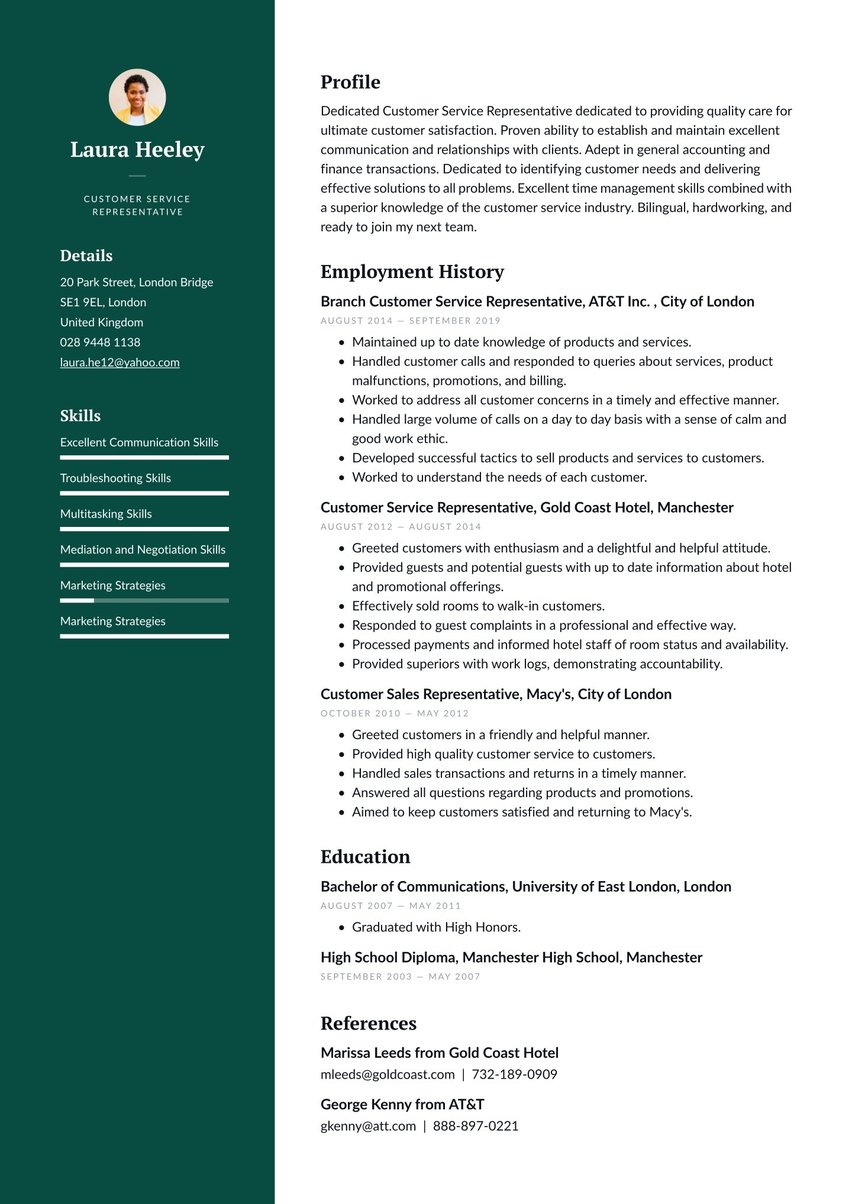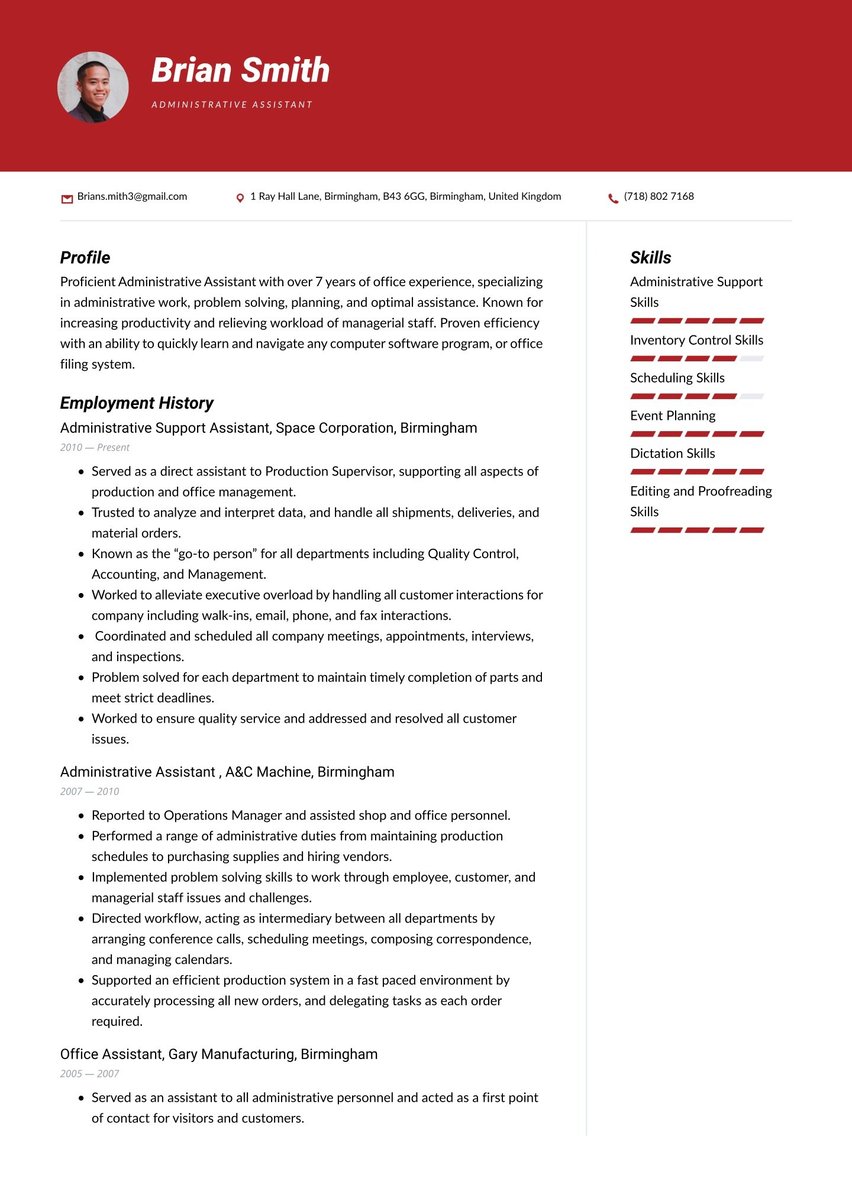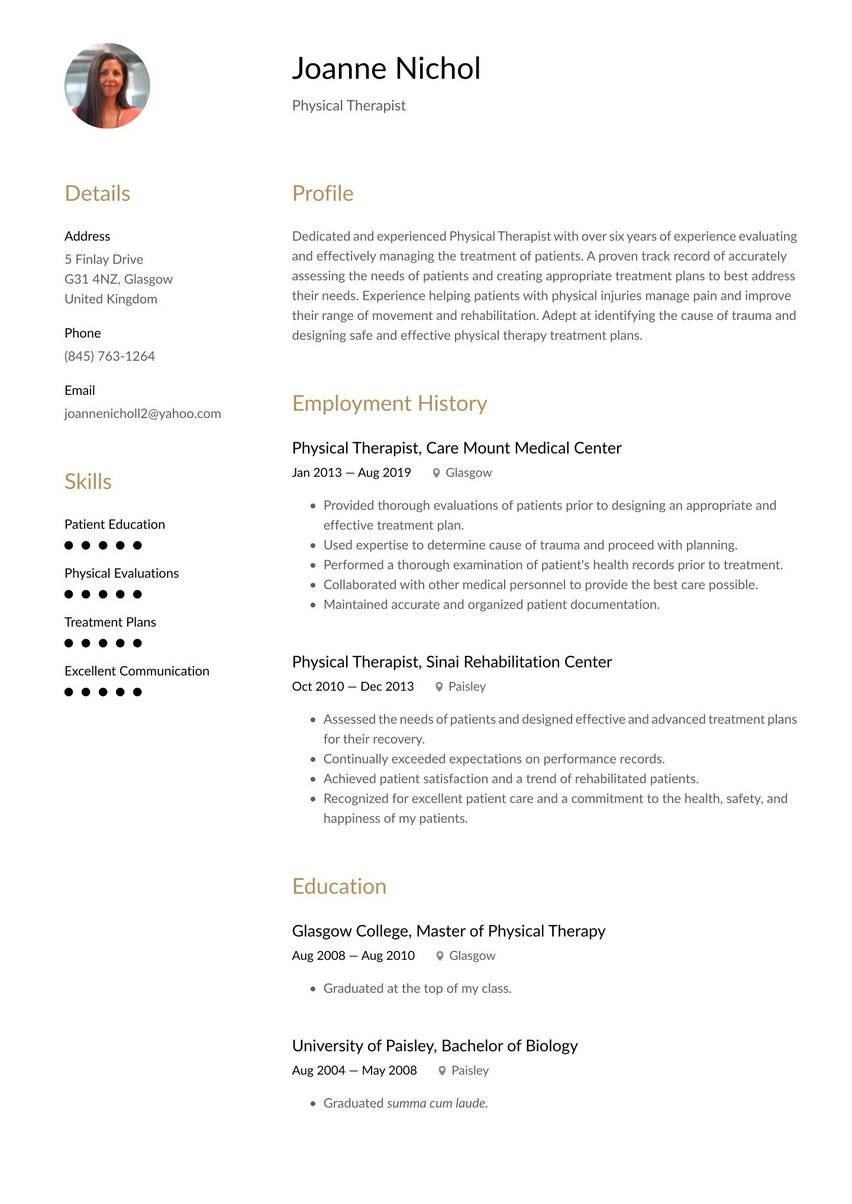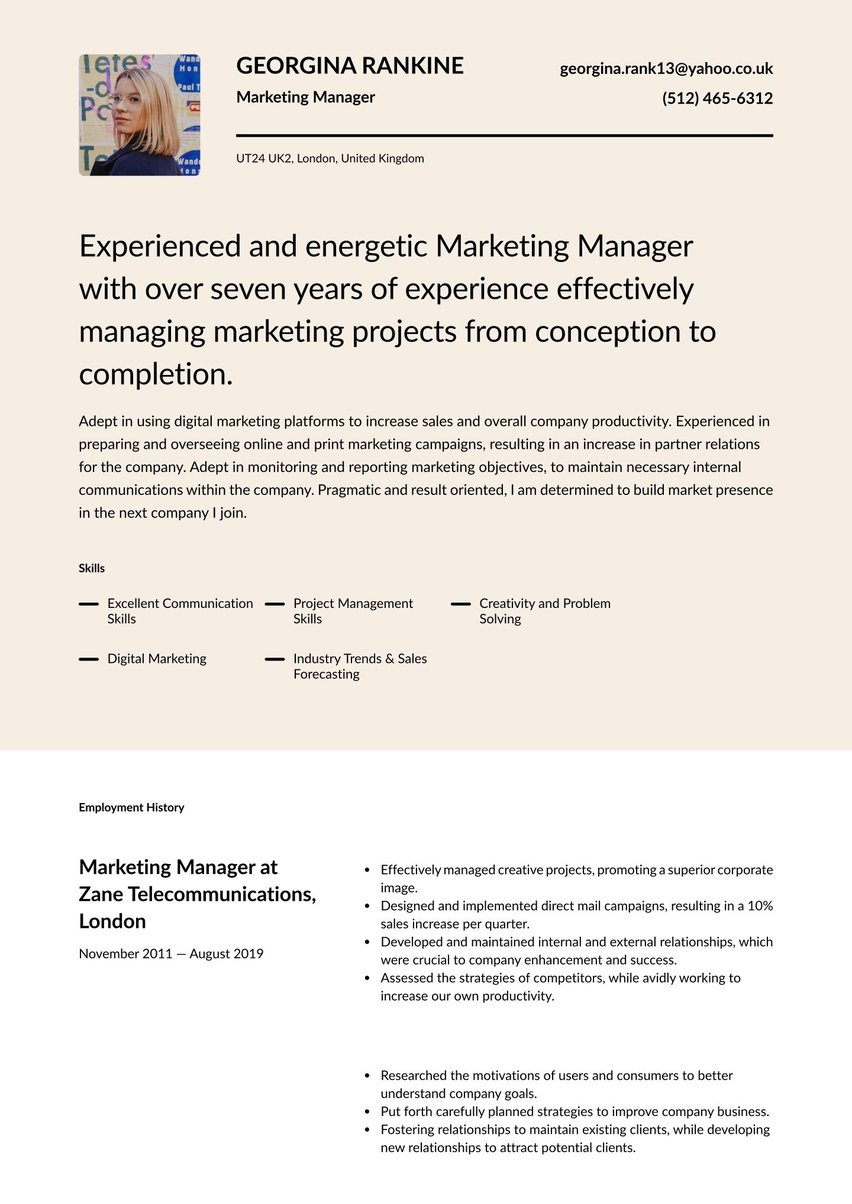Passionate and dedicated secondary school teacher with 5 years of experience in delivering engaging and effective lessons in English. Committed to inspiring and motivating students to achieve their full potential. Skilled in creating inclusive learning environments that cater to diverse student needs and promote academic and personal growth.
01/2019 - present, English Teacher, Sutton Grammar School, London
- Planned and delivered stimulating lessons in English for students aged 11-18
- Developed and implemented differentiated teaching strategies to support all learners, including those with special educational needs and English as an additional language (EAL)
- Assessed and provided feedback on student work, using data to inform teaching and learning
- Contributed to the development of schemes of work and curriculum resources
- Actively participated in extracurricular activities, including workfield excursions
- 02/2019, Postgraduate Certificate in Education (PGCE) English, King's College London, London
- 02/2018, English Language and Linguistics BA, King's College London, London
- Experienced in planning and delivering engaging
- differentiated lessons across Key Stages 3
- 4
- and 5
- Proficient in using assessment data to inform teaching and support student progress
- Strong behaviour management and interpersonal skills
- Skilled in integrating technology to enhance teaching and learning
- Committed to ongoing professional development and staying current with educational research
As a secondary school teacher, all you want is to shape the young minds of the future. However, there’s more to this taxing role than inspiring the next generation.
From lesson planning and marking to preparing for Ofsted inspections, it’s a truly challenging career. You will need a wide selection of skills and expertise to excel within this demanding industry.
But how can you convince the hiring manager that you’re the ideal candidate? Creating a secondary school teacher CV that turns heads is a tall order. Luckily, you’ve come to the right place. In the following guide, we will share the inside secrets to help you perfect this art.

CV guide for a secondary school teacher CV
Allow Resume.io to teach you how to ace this test. Our CV writing guides and CV examples cover over 150 professions. Plus, we have an easy-to-use CV builder that makes creating a flawless application effortless.
This CV guide and secondary school teacher CV example will cover the following:
- How to write a secondary school teacher CV
- Choosing the right CV format for teaching
- How to add your contact information
- Using summaries
- Adding your teaching experience
- Listing education and relevant experience
- Picking the right CV design/layout
- What the secondary school teacher job market looks like, and what salary you can expect
How to write a secondary school teacher CV
Before we get started, you need to know what to include in your CV. Make sure that this document is well-structured and easy to follow. Here are the sections you need.
- The CV header
- The CV summary (aka profile or personal statement)
- The employment history section
- The CV skills section
- The education section
So that you can land the right secondary school job, you need to ensure that your CV gets top marks. You can do that by tailoring the document to align it with the demands of the school in question.
This trick is certain to put you ahead of the competition. However, it doesn’t end there. Let’s outline some of the other ways that you can boost your chances of employment:
- Avoid generic statements. On paper, many secondary school roles will be interchangeable. However, you know that is not the truth. Rather than simply outlining your core duties, zoom in on the difference you made to students’ lives. Consider how you helped to shape these young minds and the results of your actions.
- Focus on your accomplishments. Don’t make the mistake of merely listing your duties. Instead, highlight your achievements. What results did you gain? What targets did you hit? The more specific you can be here, the better your odds will be.
- Do your homework. Before you start writing a secondary school teacher CV, you need to do your homework. That means researching the school and finding out how the structure works. Understanding the school’s ethos and vision will put you in a strong position. You can weave what you find into the body of your CV.
- Optimise your CV. To get past the CV scanning software, it’s important to incorporate specific keywords and phrases into your document. That way, you will increase your chances of your application being seen by a real-life human, not just a bot.
Optimise for the ATS
An applicant tracking system (ATS) is software that ranks CVs by how well they meet the criteria of the job. Only the highest-ranking pass the test. Reflecting on the original job advert is a quick way to find out which words you should include.
For example, a secondary school teacher job may have the following criteria:
- “Qualified Teacher Status (QTS)”
- “Strong classroom management skills”
- “Experience teaching UK Curriculum up to KS4”
If you integrate these keywords into your CV summary, it may read:
“Senior QTS French teacher with strong classroom management skills and excellent communication. Experienced in teaching UK Curriculum up to KS4 while achieving remarkable results across the board.”
Choosing the right CV format for a secondary school teacher
Next up, let’s talk about how you can choose the right CV format. Since teaching is a highly traditional job, most hiring managers will expect you to use a reverse chronological format. This is the standard structure. It means that you start with your most recent accomplishments at the top of the page. You then work your way back in time as you move down within each section.
On the other hand, if you are switching careers or are newly qualified, you should use a functional (or skills-based CV format). This puts more weight on your competencies and education than it does on your work experience. It’s all about choosing a structure that shows you in the best light as a candidate. You might want to try both before choosing one.
If you need extra help along the way, check out our selection of CV templates in our CV builder. We also have a range of CV examples, many of which use different formats.
As a general rule, make sure that you go for a simple layout here. You don’t want to make the mistake of choosing a jazzy design that does nothing but detract from your application.
Include your contact information
First things first, you need to make sure that the hiring manager can contact you. You can include your basic details within your header.
While this is a straightforward part of the application, you still need to make sure that you get it right. Here’s what you need to include in this section:
- Full name & title. Start with your first name and surname. Include your job title too.
- Professional email address. Use a formal email address. You might want to avoid using your current work email if your employer doesn’t know you’re applying elsewhere.
- Phone number. Next, you should include your mobile number or home phone number.
- Location. You don’t need to include your whole address. Instead, just put your city or town and county or country here.
- LinkedIn. While many teachers don’t use LinkedIn, if you have an account, you might want to include a hyperlink to it.
Don’t include:
- Date of birth: Letting the hiring manager know how old you are could lead to age discrimination.
- Personal details: You don’t need to include personal details, such as your marital status, whether you have kids, and your passport number.
Maria White
Married, Two Children
Young-Mind Shaper
Apt 11, Newton Road, London, UK
012 8311 4922
Make use of a summary
Your summary is the most freeform part of your CV. These 2-4 sentences need to hook the reader’s attention and give them a reason to care about the rest of your application. For that reason, you need to come up with a strong opening line that appeals to hiring managers.
Consider what your unique selling proposition (USP) is. That is the thing that you have that other candidates may lack. If you have any specialist qualifications — such as being the SENCo lead — now is the time to mention them. Think about what will make you stand out.
Bring your summary to life by including relevant action verbs. You can write these in either past or present tense, depending on which you are using. Popular options include pioneered, delivered, excelled, exceeded, and succeeded.
Don’t simply repeat the information that is elsewhere in your CV. Instead, you should focus on how your skills and expertise set you up for success. For example, you might start with “Experienced KS4 maths teacher specialising in visual learning approaches.” From that sentence, the hiring manager knows exactly what they can expect from you.
Looking for some writing inspiration? Check out our related CV examples:
You can find adaptable secondary school teacher example summaries below:
Newly Qualified Teacher (NQT) specialising in maths and chemistry. Adept at high-level classroom management, supporting a variety of students with different learning styles, and exceeding goals. Additional experience in extracurricular maths tuition.
Experienced geography teacher with expertise in delivering KS3 and KS4 lesson plans tailored to meet students’ needs. Passionate about motivating and engaging young learners while supporting their educational, social, and emotional development. Confident in lesson planning, classroom management, and delivering a range of learning approaches.
Senior-level English Literature teacher and former SENCo lead with 10+ years of experience in an educational setting. Passionate about adapting lesson plans to suit students with various learning needs. Previous experience working in an Ofsted Grade 1: Outstanding school.
Outline your teaching experience
Whether you are newly qualified or you’ve been teaching for years, it’s important to outline your work experience. Once again, you should use the reverse chronological approach when completing this part of your CV.
Your most recent position needs to be at the top of your work experience section. If you have held roles outside of teaching, you may not want to include them unless there’s some overlap. Alternatively, you can create an “Other Experience” section.
Start by listing the basics: the school (or academy) name, the location, your position, and the dates of employment. Below that, you can use bullet points to share details of your accomplishments. To save yourself some space, ditch any sentence openers like “I” or “I am”.
It’s smart to go into detail about the achievements you have gained. For example, the following statements don’t add much value to your teaching CV:
- “Prepared teaching materials and planned lessons”
- “Improved test results”
- “Marked students’ assignments”
While these may comprise some of your main duties, they are not entirely descriptive. A better approach is to be more specific about the results you gained:
- “Structured a clear curriculum for KS4 with adaptations to suit AuDHD learners”
- “Boosted GCSE Maths results by 18% overall since taking the role”
- “Marked assignments and offered detailed feedback leading to a 5% increase in results”
The more evidence you provide the hiring manager with, the more likely you are to land the role. Take a look at the secondary school teacher employment history CV sample below:
English Teacher at Sutton Grammar School, London
2019 - Present
- Planned and delivered stimulating lessons in English for students aged 11-18
- Developed and implemented differentiated teaching strategies to support all learners, including those with special educational needs and English as an additional language (EAL)
- Assessed and provided feedback on student work, using data to inform teaching and learning
- Contributed to the development of schemes of work and curriculum resources
- Actively participated in extracurricular activities, including workfield excursions
How to write a secondary school teacher CV with no experience
If you have recently completed your PGCE but have yet to land a formal teaching role, allow your CV to do the talking. Of course, you will already have some classroom experience since this is central to teaching courses. You can use the experience that you do have here.
Focus on your transferable skills and what has driven you to become a teacher. If you have held jobs that overlap with teaching—such as that of a teaching assistant or a tutor—you should include them on your CV. While you may lack direct experience, these positions prove that you understand what it takes to work with young people and get the results that you need.
You can also use extracurriculars to bolster your CV. For example, if you have run a kids’ club, worked as an au pair, or managed a youth sports team, that is entirely relevant. You could create a section of either “Voluntary experience” or “Extracurricular” to support these points.
Include the relevant key skills that make you a great secondary school teacher
Teaching is a challenging role. So, it should come as no surprise that you need a balanced skill set to excel in it. With that in mind, you should make sure that your secondary school teacher CV includes both hard skills and soft skills.
Hard skills tend to apply directly to the role at hand. For example, they may include knowledge of child development, curriculum planning, and classroom management. On the other hand, soft skills are transferable and work for a selection of professions. Examples include communication, time management, and organisation to name a few.
Our CV builder offers pre-selected skills, and you can add your own to the mix. Take a look at the skills box for our CV template for secondary school teachers.
- Experienced in planning and delivering engaging, differentiated lessons across Key Stages 3, 4, and 5
- Proficient in using assessment data to inform teaching and support student progress
- Strong behaviour management and interpersonal skills
- Skilled in integrating technology to enhance teaching and learning
- Committed to ongoing professional development and staying current with educational research
Wherever possible, you need to give context to the skills that you list. While you need to use a bullet-point system in the skills section, you can elaborate on them elsewhere in your CV. For example, you might choose to take the following approaches:
- Explain how you used British Sign Language (BSL) to communicate with students with hearing difficulties.
- Talk about how you used your collaborative skills to work with other teachers and develop curriculums together.
- Stress how your child development knowledge prepared you for a career in teaching.
If you are unsure which skills you should include in your secondary school teacher CV, refer back to the job advert. The criteria listed there is a smart place to start.
Detail your education & relevant teaching certifications
As a teacher, you already know the importance of education. This CV section carries the most weight and is a good opportunity for you to show off your qualifications. Since there are many different routes to becoming a secondary school teacher, you need to be specific about yours.
Be sure to list your teaching qualifications at the top of this section. If you have also gained any continuous development certificates or training, you can include them lower down on the page. You might even choose to create an “Additional training” section, for example.
You don’t need to include your own school results here. You are way beyond having to put your GCSE or even A Level grades on applications. However, you may include the following:
- Postgraduate Certification in Education (PGCE). This is the most common route to becoming a teacher in the United Kingdom. You can gain this qualification through teacher training or via a university degree.
- Level 5 Diploma in Education and Training (RQF). Another less popular option is to complete this diploma-based course. This one allows you to gain Qualified Teacher Status without going to university.
- Qualified Teacher Learning and Skills (QTLS). Another non-university pathway is gaining the QTLS status instead. You can complete this training on the job but you will need to be a Society for Education and Training member to qualify.
- Additional qualifications. The truth of the matter is that there are many routes to becoming a teacher in the UK. Teach First has a wide selection of options from candidates with different backgrounds. Whatever training you have, be clear about it.
Take a quick look at our education section example below.
Postgraduate Certificate in Education (PGCE) English, King's College London, London
2019
English Language and Linguistics BA, King's College London, London
2018
Pick the right CV layout and design for a secondary school teacher CV
You want your secondary school teacher CV to stand out from the crowd. To make that happen, you need to ensure that it is clean and easy to read. When choosing the design of your CV, always favour white space and a simplistic look. This will appeal to the hiring manager.
Equally, you want to choose a font that works for the reader. Opt for something that is clear and won’t detract from the content of your CV. Make sure that it can be read both on and off-screen.
We recommend choosing a professional look from our selection of CV templates. Each has been designed with the hiring manager’s interests at heart. We have a range of Modern, Creative, Simple, and Professional styles from which to choose. Pick the right one for you!
Secondary school teacher text-only CV example
Profile
Passionate and dedicated secondary school teacher with 5 years of experience in delivering engaging and effective lessons in English. Committed to inspiring and motivating students to achieve their full potential. Skilled in creating inclusive learning environments that cater to diverse student needs and promote academic and personal growth.
Employment history
English Teacher at Sutton Grammar School, London
2019 - Present
- Planned and delivered stimulating lessons in English for students aged 11-18
- Developed and implemented differentiated teaching strategies to support all learners, including those with special educational needs and English as an additional language (EAL)
- Assessed and provided feedback on student work, using data to inform teaching and learning
- Contributed to the development of schemes of work and curriculum resources
- Actively participated in extracurricular activities, including workfield excursions
Skills
- Experienced in planning and delivering engaging, differentiated lessons across Key Stages 3, 4, and 5
- Proficient in using assessment data to inform teaching and support student progress
- Strong behaviour management and interpersonal skills
- Skilled in integrating technology to enhance teaching and learning
- Committed to ongoing professional development and staying current with educational research
Education
Postgraduate Certificate in Education (PGCE) English, King's College London, London
2019
English Language and Linguistics BA, King's College London, London
2018
Secondary school teacher job market and outlook
Teacher supply is in a “critical state” in the United Kingdom, with many schools struggling to recruit. In the 2023/24 year, overall secondary recruitment reached half of its target. Additionally, 44% more teachers stated that they intended to leave the profession than the previous year.
Put simply, there’s a massive demand for secondary school teachers currently. Whether you are an experienced teacher or new to the profession, there will be many vacancies available to you. For that reason, it is well worth creating a secondary school teacher CV that opens doors.
What type of salary you can expect as a secondary school teacher
According to the National Careers Service, secondary school teachers can make between £30,000 and £47,000 per year. That is based on working around 37 to 45 hours during term time (plus additional planning time at home!).
Key takeaways for building a secondary school teacher CV
When crafting your secondary school teacher CV, you need to prove your value to the hiring manager. Show off what skills and training you have that set you apart from the crowd.
You should also tailor your CV to meet the demands of the school or academy you are applying to work at. Finish things off with a simple, professional design that appeals to the reader.
Get started now by using our CV builder. We have a wide selection of tried and tested CV templates to help you get the job done.

































